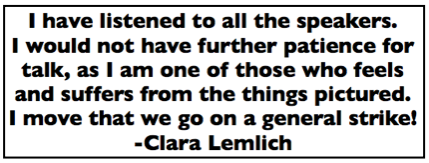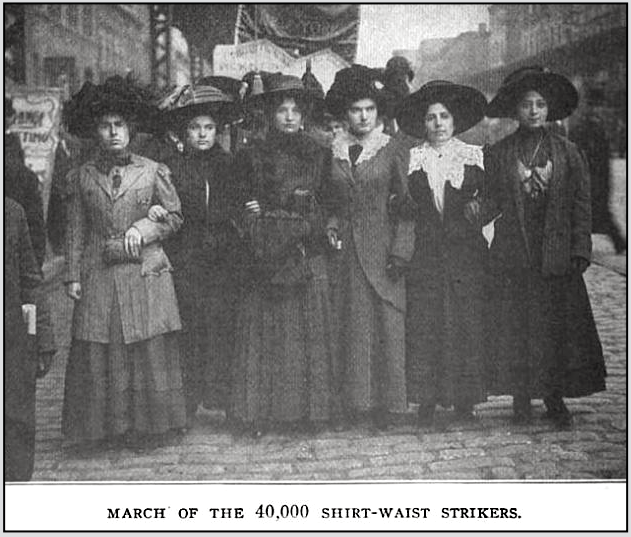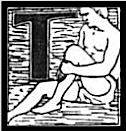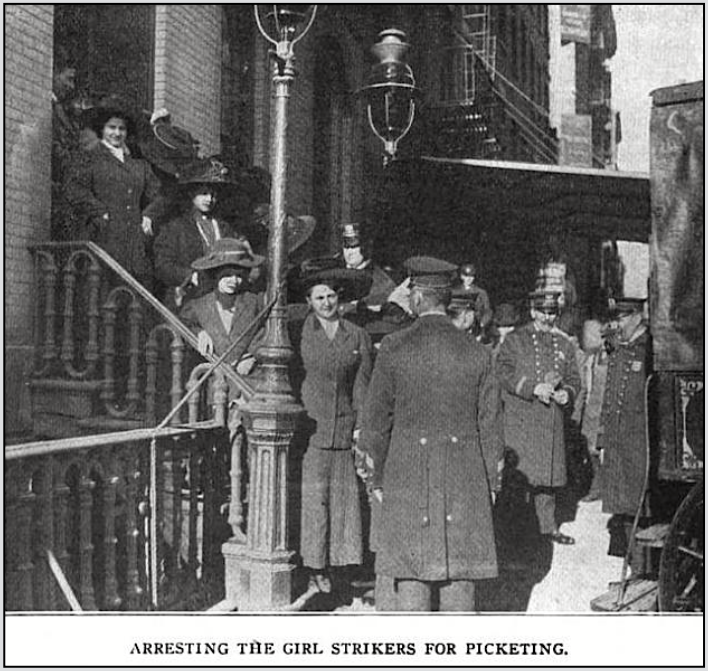 ———-
———-
Hellraisers Journal – Tuesday January 11, 1910
Rose Strunsky on New York City’s Shirtwaist Uprising, Part I
From the International Socialist Review of January 1910:
The Strike of the Singers of the Shirt
—–By Rose Strunsky.
—–[Part I of II.]
HE Song of the Shirt in chorus! The fact is momentous. The lyric becomes an epic. The plaint becomes a war-song. It becomes a man song.
It is historic. The singer has come out of the garret. She has dropped her needle and bends over her machine in the crowded tenement of a shopkeeper or in the loft of a manufacturer. There are rows upon rows of machines next to her, and she sings the Song of the Shirt in chorus. It is the death of the woman. It is the birth of the sexless laborer.
As woman she was in the field of labor as man’s scab. She underbid him. She was an accident in the field the stones to be picked up for loading the sling of the capitalist.
That this most finely developed industrial country should be the first to turn woman into the laborer was historically logical and to be foreseen, and now this great dramatic and vital birth has happened—happened by the new Singers of the Shirt; by the general strike of the forty thousand shirt-waist makers of New York, which began on November 23rd.
This new-born laborer, this woman per se of yesterday, has taken the slug-horn to her lips and called out her armies upon that battlefield where she had been but a tool these hundred years of industrial transition, and, stern-eyed and intense, has made her first charge against the enemy. The act is impressive and significant and has the beauty which comes with a noble growth and the sadness which accompanies beauty and growth. The outbreak was strong and unexpected though for years the foundations of it were laid by quiet propaganda as well as economic necessity.
The necessity for organization had been realized by the men almost as soon as the industrial revolution took place. The great difficulty was to make the women see it also now that they had entered upon the field; and to the shame of the men laborers may it be said that they did little to help their sisters realize the necessity and advantages of union. They were blinded by a short-sighted jealousy; they did not seem to realize that they belonged to the same class and that if kept divided, it would be as unfortunate for the men as for the women themselves.
The first conscious effort to organize the women in America was made in 1903, when Miss Mary K. O’Sullivan and William English Walling formed the nucleus of an organization, which was called the Woman’s Trade Union League. A meeting was held during a convention of the American Federation of Labor, and several officers of that organization were induced to attend, in order to aid and give their support. The League, after passing through the hardships of its formative period, succeeded in establishing itself on a firm basis and has proven of great aid in spreading unionism. Already it controls ten thousand organized women, but its seed has fallen farther than its members themselves knew, as was shown by the response of the shirt-waist makers to go out on the general strike, the majority of them being unorganized.
The League led the six months’ strike of the cotton operatives in Fall River, Massachusetts, and worked in behalf of the striking laundry workers of Troy; it took up the bakers’ strike of this city and now, like a careful mother, is tenderly watching and caring for this first large battle of the women workers on the field of labor.
The cause of the general strike was the unrest in the shirt-waist making industry. In September the Triangle Shirt Waist factory struck. A system of sub-contracting, which nearly all the shops have, was going on there with great abuses. The employer hired a man for twenty dollars a week, who in turn contracted shirt-waist makers at any price he could get them for, and so squeezing the wage down to as low as four and five dollars a week. The girls worked from eight in the morning to nine in the evening four times a week and half a day on Sunday. Strange to say, the strike in this factory was caused by the sub-contractor himself. He quarreled with the employer, and in leaving the place, he turned to the girls and told them to follow him. They left their machines and went out. The next day they were urged to come back, but they were then laid off for a month on the pretext of lack of work, while the employers advertised in the Italian, Jewish and English papers for shirtwaist makers.
The strike was on. When the former employees went to the shop to inform the girls who were answering the advertisements that the shop was on strike, they were arrested, mistreated and fined by the courts.
The enemy, too, recognized that the question of sex was gone, that she was no longer woman but laborer, and that she was to be fought in the same way as the man laborer.
From September to October 103 arrests were made for picketing, the girls all being fined. Thugs were immediately employed to guard the scabs and policemen to help the thugs.
As the conditions in other shops were no better than in this Triangle Shirt-Waist factory, the unrest among the workers grew. On November 23rd it was decided to call mass meetings to discuss conditions. Four halls were crowded. The largest, which was Cooper Union, was presided over by the Woman’s Trade Union League and had among its speakers Mr. Gompers. Gompers made a characteristic speech to them:
[He said:]
I have never declared for a strike in all my life. I have done my best to prevent strikes, but there comes a time when not to strike rivets the chains on our wrists.
The shirt-waist makers listened to many more such speeches. They had come to the meeting heavy-hearted and depressed. It meant suffering to continue work under their conditions, and it meant suffering to fight. Would they succeed in the fight? Could they succeed? Would the rest of the girls, for whom it was so difficult to grasp the advantages of solidarity, join in a general strike? Did they have the strength of character, the nobility of purpose?
The speakers, one after the other, argued about the possibilities of victory and discussed the methods of employers. In the midst of these speeches Clara Lemlich, a dark, pale little girl of about 20, raised her hand to show her desire to speak. She was called upon, and willing hands lifted her on the platform. With the simplicity of genius she said:
I have listened to all the speakers, and I have no patience for talk. I am one who feels and suffers from the things pictured. I move that we go on a general strike.
It was the expression of the heart of the audience. It jumped to its feet and cheered approval. It was for this they had come together, these thousands of isolated girls. Unknown to themselves they had come to unite into one army for the benefit of all. They had come to declare war.
A committee of fifteen was appointed to go to the other halls to announce the decision of the Cooper Union meeting. As the committee entered each well-packed hall and told of the call to arms, it was applauded and cheered for many minutes.
[Emphasis added.]
~~~~~~~~~~~~~~~~~~~~~~
SOURCES & IMAGES
Quote Clara Lemlich at Cooper Un Nov 22, NY Call p2, Nov 23, 1909
https://www.marxists.org/history/usa/pubs/the-new-york-call/1909/091123-newyorkcall-v02n287.pdf
The International Socialist Review, Volume 10
(Chicago, Illinois)
-July 1909-June 1910
C. H. Kerr & Company, 1910
https://books.google.com/books?id=MVhIAAAAYAAJ
ISR – Jan 1910
https://play.google.com/books/reader?id=MVhIAAAAYAAJ&printsec=frontcover&pg=GBS.PA577
“Strike of the Singers of the Shirt” by Rose Strunsky
https://play.google.com/books/reader?id=MVhIAAAAYAAJ&printsec=frontcover&pg=GBS.PA620
See also:
Tag: NYC Waistmakers Uprising of 1909-1910
https://weneverforget.org/tag/nyc-waistmakers-uprising-of-1909-1910/
Poem: “Song of the Shirt” by Thomas Hood, 1843
https://en.wikipedia.org/wiki/The_Song_of_the_Shirt
https://www.cummingsstudyguides.net/Guides5/SongofShirt.html#Text
Film: “Song of the Shirt” -1908
https://archive.org/details/TheSongOfTheShirt_201402
Rose Strunsky
https://spartacus-educational.com/Rose_Strunsky.htm
Mary Kenney O’Sullivan
https://en.wikipedia.org/wiki/Mary_Kenney_O%27Sullivan
William English Walling
https://en.wikipedia.org/wiki/William_English_Walling
Women’s Trade Union League
https://en.wikipedia.org/wiki/Women%27s_Trade_Union_League
Re Fall River MA Textile Strike of 1904, see:
The American Pressman, Volume 15
International Printing Pressmen and Assistants’ Union of North America, 1904
(search: fall river strike)
https://books.google.com/books?id=MZn-gZ-8dtsC
Re Troy NY Laundry Workers Strike of 1905, see:
Charities and The Commons of Nov 18, 1905
-“Women Strikers of Troy” by Rheta Childe Dorr
https://play.google.com/books/reader?id=UTJHAQAAIAAJ&hl=en&pg=GBS.PA233
Re New York City Bakers’ Strike of 1909-1910, see:
The Survey of June 18, 1910
-“A Strike for Clean Bread” by Mary Brown Sumner
https://play.google.com/books/reader?id=HpsJAAAAIAAJ&hl=en&pg=GBS.PA483
Tag: Triangle Shirtwaist Factory Fire
https://weneverforget.org/tag/triangle-shirtwaist-factory-fire/
Tag: Clara Lemlich
https://weneverforget.org/tag/clara-lemlich/
~~~~~~~~~~~~~~~~~~~~~~~~~~~~~~~~~~~~~~~~~~~~~
The Song of the Shirt – D. W. Griffith’s 1908 film.
The Song of the Shirt by Thomas Hood



